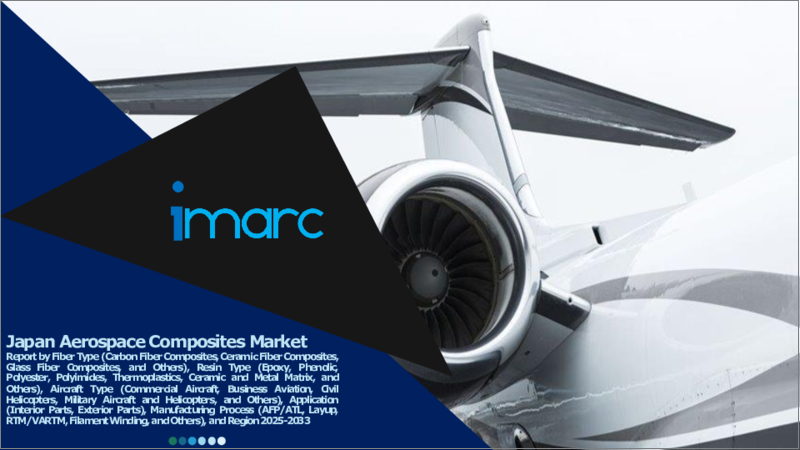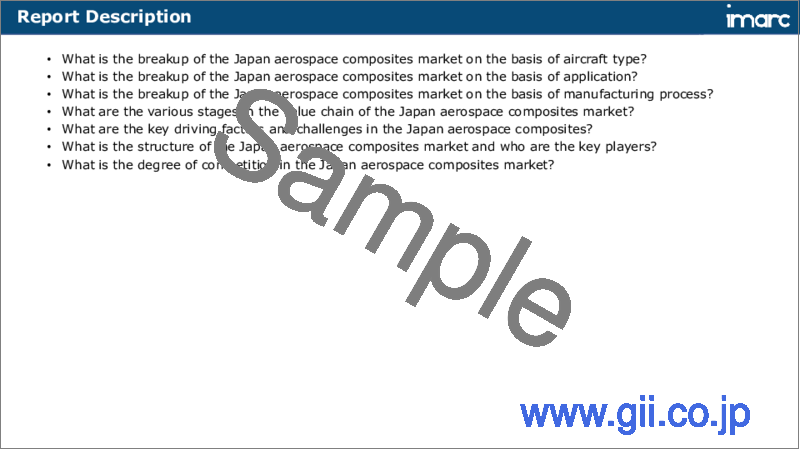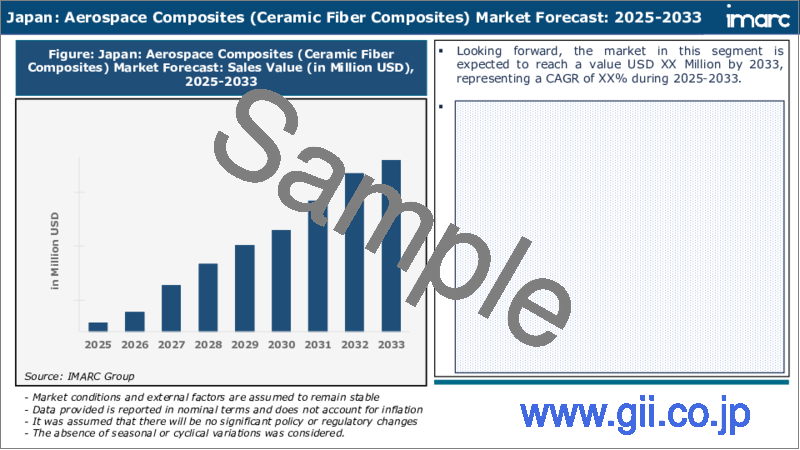|
|
市場調査レポート
商品コード
1609663
日本の航空宇宙用複合材料市場レポート:繊維タイプ、樹脂タイプ、航空機タイプ、用途、製造プロセス、地域別、2025年~2033年Japan Aerospace Composites Market Report by Fiber Type, Resin Type, Aircraft Type, Application, Manufacturing Process, and Region 2025-2033 |
||||||
カスタマイズ可能
|
|||||||
| 日本の航空宇宙用複合材料市場レポート:繊維タイプ、樹脂タイプ、航空機タイプ、用途、製造プロセス、地域別、2025年~2033年 |
|
出版日: 2024年12月05日
発行: IMARC
ページ情報: 英文 122 Pages
納期: 5~7営業日
|
- 全表示
- 概要
- 目次
日本の航空宇宙用複合材料市場の市場規模は2024年に13億4,700万米ドルに達しました。今後、IMARC Groupは、市場は2033年までに20億7,200万米ドルに達し、2025年から2033年にかけて4.4%の成長率(CAGR)を示すと予測しています。航空宇宙産業の拡大に加え、燃費向上と環境負荷低減を目的とした軽量素材への注目の高まりが市場を牽引しています。
本レポートで扱う主な質問
- 日本の航空宇宙用複合材料市場はこれまでどのように推移し、今後どのように推移するのか?
- COVID-19が日本の航空宇宙用複合材料市場に与えた影響は?
- 日本の航空宇宙用複合材料市場のファイバータイプ別の内訳は?
- 日本の航空宇宙用複合材料市場の樹脂別構成比は?
- 日本の航空宇宙用複合材料市場の航空機タイプ別の内訳を教えてください。
- 日本の航空宇宙用複合材料市場の用途別の内訳は?
- 日本の航空宇宙用複合材料市場の製造工程別の内訳は?
- 日本の航空宇宙用複合材料市場のバリューチェーンにはどのような段階がありますか?
- 日本の航空宇宙用複合材料の主な促進要因と課題は?
- 日本の航空宇宙用複合材料市場の構造と主要プレーヤーは?
- 日本の航空宇宙用複合材料市場における競合の程度は?
目次
第1章 序文
第2章 調査範囲と調査手法
- 調査の目的
- ステークホルダー
- データソース
- 市場推定
- 調査手法
第3章 エグゼクティブサマリー
第4章 日本の航空宇宙用複合材料市場-イントロダクション
- 概要
- 市場力学
- 業界動向
- 競合情報
第5章 日本の航空宇宙用複合材料市場情勢
- 過去および現在の市場動向(2019年~2024年)
- 市場予測(2025年~2033年)
第6章 日本の航空宇宙用複合材料市場- 繊維タイプ別の内訳
- 炭素繊維複合材料
- セラミック繊維複合材料
- ガラス繊維複合材料
- その他
第7章 日本の航空宇宙用複合材料市場- 樹脂タイプ別の内訳
- エポキシ
- フェノール
- ポリエステル
- ポリイミド
- 熱可塑性プラスチック
- セラミックと金属マトリックス
- その他
第8章 日本の航空宇宙用複合材料市場- 航空機タイプ別の内訳
- 民間航空機
- ビジネス航空
- 民間ヘリコプター
- 軍用機とヘリコプター
- その他
第9章 日本の航空宇宙用複合材料市場- 用途別の内訳
- 内装部品
- 外装パーツ
第10章 日本の航空宇宙用複合材料市場- 製造プロセス別内訳
- AFP/ATL
- レイアップ
- RTM/VARTM
- フィラメントワインディング
- その他
第11章 日本の航空宇宙用複合材料市場-競合情勢
- 概要
- 市場構造
- 市場プレーヤーのポジショニング
- 主要成功戦略
- 競合ダッシュボード
- 企業評価象限
第12章 主要企業のプロファイル
第13章 日本の航空宇宙用複合材料市場- 業界分析
- 促進要因・抑制要因・機会
- ポーターのファイブフォース分析
- バリューチェーン分析
第14章 付録
Japan aerospace composites market size reached USD 1,347 Million in 2024. Looking forward, IMARC Group expects the market to reach USD 2,072 Million by 2033, exhibiting a growth rate (CAGR) of 4.4% during 2025-2033. The expanding aerospace industry, along with the growing focus on lightweight materials to improve fuel efficiency and reduce environmental, is driving the market.
Aerospace composites are advanced materials used in the construction of aircraft and spacecraft, composed of two or more distinct components with different physical or chemical properties. Typically, these composites combine a reinforcing fiber material, such as carbon or glass, with a matrix material, often a polymer resin. This combination results in a material that exhibits superior strength, stiffness, and lightness compared to traditional materials like aluminum or steel. Aerospace composites are crucial in the aviation and space industries, enabling the production of lightweight structures that enhance fuel efficiency and overall performance. They also contribute to increased durability, corrosion resistance, and improved aerodynamics. The development and utilization of aerospace composites represent a significant technological advancement, driving innovation in aircraft design and manufacturing processes to meet the demanding requirements of modern aerospace engineering.
Japan Aerospace Composites Market Trends:
The aerospace composites market in Japan is experiencing unprecedented growth, driven by a confluence of factors that underscore the industry's evolution. Firstly, advancements in material science have catalyzed a paradigm shift towards lightweight and high-strength composites, compelling aerospace manufacturers to integrate these materials into their designs. This transformative trend is further bolstered by stringent environmental regulations, where the imperative to reduce fuel consumption and emissions propels the demand for composites that enhance aircraft fuel efficiency. Moreover, the aerospace sector's incessant pursuit of innovation has spurred R&D initiatives, fostering a continuous stream of cutting-edge composite technologies. This dynamic ecosystem of innovation not only enhances the performance characteristics of aerospace composites but also contributes to cost-effectiveness in production processes. Simultaneously, the surging regional air travel demand acts as a potent catalyst, compelling the aviation industry to adopt composites to optimize aircraft performance and longevity. Furthermore, the strategic partnerships and collaborations between aerospace companies and composite material suppliers, which ensure seamless integration of advanced materials into aircraft manufacturing, are expected to drive the market in Japan during the forecast period.
Japan Aerospace Composites Market Segmentation:
Fiber Type Insights:
- Carbon Fiber Composites
- Ceramic Fiber Composites
- Glass Fiber Composites
- Others
Resin Type Insights:
- Epoxy
- Phenolic
- Polyester
- Polyimides
- Thermoplastics
- Ceramic and Metal Matrix
- Others
Aircraft Type Insights:
- Commercial Aircraft
- Business Aviation
- Civil Helicopters
- Military Aircraft and Helicopters
- Others
Application Insights:
- Interior Parts
- Exterior Parts
Manufacturing Process Insights:
- AFP/ATL
- Layup
- RTM/VARTM
- Filament Winding
- Others
Competitive Landscape:
The market research report has also provided a comprehensive analysis of the competitive landscape. Competitive analysis such as market structure, key player positioning, top winning strategies, competitive dashboard, and company evaluation quadrant has been covered in the report. Also, detailed profiles of all major companies have been provided.
Key Questions Answered in This Report:
- How has the Japan aerospace composites market performed so far and how will it perform in the coming years?
- What has been the impact of COVID-19 on the Japan aerospace composites market?
- What is the breakup of the Japan aerospace composites market on the basis of fiber type?
- What is the breakup of the Japan aerospace composites market on the basis of resin type?
- What is the breakup of the Japan aerospace composites market on the basis of aircraft type?
- What is the breakup of the Japan aerospace composites market on the basis of application?
- What is the breakup of the Japan aerospace composites market on the basis of manufacturing process?
- What are the various stages in the value chain of the Japan aerospace composites market?
- What are the key driving factors and challenges in the Japan aerospace composites?
- What is the structure of the Japan aerospace composites market and who are the key players?
- What is the degree of competition in the Japan aerospace composites market?
Table of Contents
1 Preface
2 Scope and Methodology
- 2.1 Objectives of the Study
- 2.2 Stakeholders
- 2.3 Data Sources
- 2.3.1 Primary Sources
- 2.3.2 Secondary Sources
- 2.4 Market Estimation
- 2.4.1 Bottom-Up Approach
- 2.4.2 Top-Down Approach
- 2.5 Forecasting Methodology
3 Executive Summary
4 Japan Aerospace Composites Market - Introduction
- 4.1 Overview
- 4.2 Market Dynamics
- 4.3 Industry Trends
- 4.4 Competitive Intelligence
5 Japan Aerospace Composites Market Landscape
- 5.1 Historical and Current Market Trends (2019-2024)
- 5.2 Market Forecast (2025-2033)
6 Japan Aerospace Composites Market - Breakup by Fiber Type
- 6.1 Carbon Fiber Composites
- 6.1.1 Overview
- 6.1.2 Historical and Current Market Trends (2019-2024)
- 6.1.3 Market Forecast (2025-2033)
- 6.2 Ceramic Fiber Composites
- 6.2.1 Overview
- 6.2.2 Historical and Current Market Trends (2019-2024)
- 6.2.3 Market Forecast (2025-2033)
- 6.3 Glass Fiber Composites
- 6.3.1 Overview
- 6.3.2 Historical and Current Market Trends (2019-2024)
- 6.3.3 Market Forecast (2025-2033)
- 6.4 Others
- 6.4.1 Historical and Current Market Trends (2019-2024)
- 6.4.2 Market Forecast (2025-2033)
7 Japan Aerospace Composites Market - Breakup by Resin Type
- 7.1 Epoxy
- 7.1.1 Overview
- 7.1.2 Historical and Current Market Trends (2019-2024)
- 7.1.3 Market Forecast (2025-2033)
- 7.2 Phenolic
- 7.2.1 Overview
- 7.2.2 Historical and Current Market Trends (2019-2024)
- 7.2.3 Market Forecast (2025-2033)
- 7.3 Polyester
- 7.3.1 Overview
- 7.3.2 Historical and Current Market Trends (2019-2024)
- 7.3.3 Market Forecast (2025-2033)
- 7.4 Polyimides
- 7.4.1 Overview
- 7.4.2 Historical and Current Market Trends (2019-2024)
- 7.4.3 Market Forecast (2025-2033)
- 7.5 Thermoplastics
- 7.5.1 Overview
- 7.5.2 Historical and Current Market Trends (2019-2024)
- 7.5.3 Market Forecast (2025-2033)
- 7.6 Ceramic and Metal Matrix
- 7.6.1 Overview
- 7.6.2 Historical and Current Market Trends (2019-2024)
- 7.6.3 Market Forecast (2025-2033)
- 7.7 Others
- 7.7.1 Historical and Current Market Trends (2019-2024)
- 7.7.2 Market Forecast (2025-2033)
8 Japan Aerospace Composites Market - Breakup by Aircraft Type
- 8.1 Commercial Aircraft
- 8.1.1 Overview
- 8.1.2 Historical and Current Market Trends (2019-2024)
- 8.1.3 Market Forecast (2025-2033)
- 8.2 Business Aviation
- 8.2.1 Overview
- 8.2.2 Historical and Current Market Trends (2019-2024)
- 8.2.3 Market Forecast (2025-2033)
- 8.3 Civil Helicopters
- 8.3.1 Overview
- 8.3.2 Historical and Current Market Trends (2019-2024)
- 8.3.3 Market Forecast (2025-2033)
- 8.4 Military Aircraft and Helicopters
- 8.4.1 Overview
- 8.4.2 Historical and Current Market Trends (2019-2024)
- 8.4.3 Market Forecast (2025-2033)
- 8.5 Others
- 8.5.1 Historical and Current Market Trends (2019-2024)
- 8.5.2 Market Forecast (2025-2033)
9 Japan Aerospace Composites Market - Breakup by Application
- 9.1 Interior Parts
- 9.1.1 Overview
- 9.1.2 Historical and Current Market Trends (2019-2024)
- 9.1.3 Market Forecast (2025-2033)
- 9.2 Exterior Parts
- 9.2.1 Overview
- 9.2.2 Historical and Current Market Trends (2019-2024)
- 9.2.3 Market Forecast (2025-2033)
10 Japan Aerospace Composites Market - Breakup by Manufacturing Process
- 10.1 AFP/ATL
- 10.1.1 Overview
- 10.1.2 Historical and Current Market Trends (2019-2024)
- 10.1.3 Market Forecast (2025-2033)
- 10.2 Layup
- 10.2.1 Overview
- 10.2.2 Historical and Current Market Trends (2019-2024)
- 10.2.3 Market Forecast (2025-2033)
- 10.3 RTM/VARTM
- 10.3.1 Overview
- 10.3.2 Historical and Current Market Trends (2019-2024)
- 10.3.3 Market Forecast (2025-2033)
- 10.4 Filament Winding
- 10.4.1 Overview
- 10.4.2 Historical and Current Market Trends (2019-2024)
- 10.4.3 Market Forecast (2025-2033)
- 10.5 Others
- 10.5.1 Historical and Current Market Trends (2019-2024)
- 10.5.2 Market Forecast (2025-2033)
11 Japan Aerospace Composites Market - Competitive Landscape
- 11.1 Overview
- 11.2 Market Structure
- 11.3 Market Player Positioning
- 11.4 Top Winning Strategies
- 11.5 Competitive Dashboard
- 11.6 Company Evaluation Quadrant
12 Profiles of Key Players
- 12.1 Company A
- 12.1.1 Business Overview
- 12.1.2 Product Portfolio
- 12.1.3 Business Strategies
- 12.1.4 SWOT Analysis
- 12.1.5 Major News and Events
- 12.2 Company B
- 12.2.1 Business Overview
- 12.2.2 Product Portfolio
- 12.2.3 Business Strategies
- 12.2.4 SWOT Analysis
- 12.2.5 Major News and Events
- 12.3 Company C
- 12.3.1 Business Overview
- 12.3.2 Product Portfolio
- 12.3.3 Business Strategies
- 12.3.4 SWOT Analysis
- 12.3.5 Major News and Events
- 12.4 Company D
- 12.4.1 Business Overview
- 12.4.2 Product Portfolio
- 12.4.3 Business Strategies
- 12.4.4 SWOT Analysis
- 12.4.5 Major News and Events
- 12.5 Company E
- 12.5.1 Business Overview
- 12.5.2 Product Portfolio
- 12.5.3 Business Strategies
- 12.5.4 SWOT Analysis
- 12.5.5 Major News and Events
13 Japan Aerospace Composites Market - Industry Analysis
- 13.1 Drivers, Restraints, and Opportunities
- 13.1.1 Overview
- 13.1.2 Drivers
- 13.1.3 Restraints
- 13.1.4 Opportunities
- 13.2 Porters Five Forces Analysis
- 13.2.1 Overview
- 13.2.2 Bargaining Power of Buyers
- 13.2.3 Bargaining Power of Suppliers
- 13.2.4 Degree of Competition
- 13.2.5 Threat of New Entrants
- 13.2.6 Threat of Substitutes
- 13.3 Value Chain Analysis






